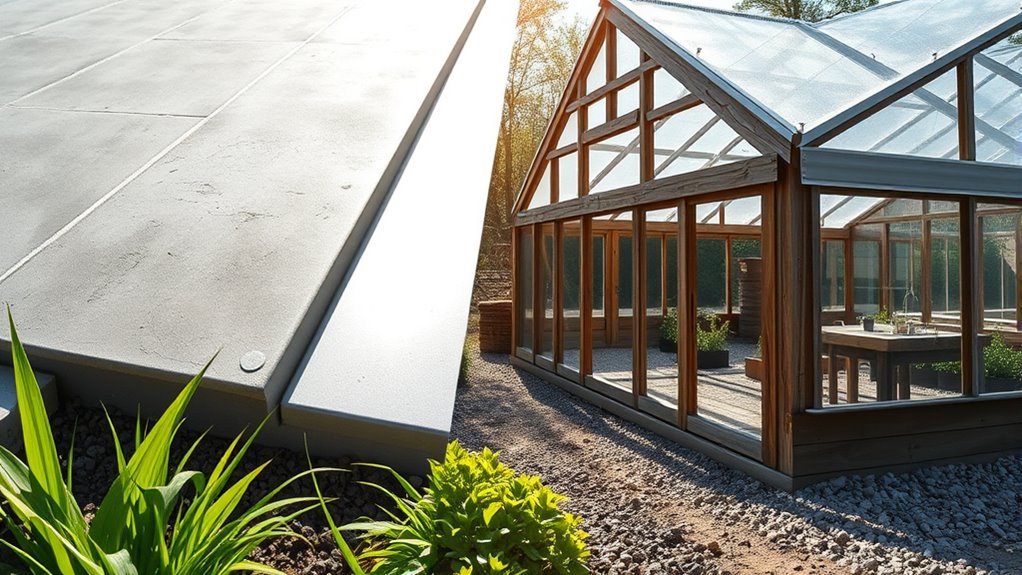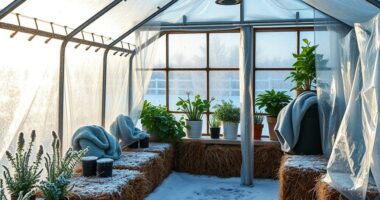When you’re installing a greenhouse foundation, concrete stands out for its durability and stability. It resists harsh weather and deters pests, plus it provides a solid, level surface for assembly. While wood and soil foundations are cheaper, they need more maintenance and aren’t as robust. Consider drainage solutions for each type to ensure long-lasting performance. If you want to explore the pros and cons of different foundation options, there’s more to discover.
Key Takeaways
- Concrete foundations offer superior durability and stability, resisting extreme weather and pests while providing a level surface for assembly.
- Concrete costs between $4 to $8 per square foot, while wood and soil foundations are more budget-friendly but require ongoing maintenance.
- Drainage is crucial; concrete should slope toward drains, while wooden foundations benefit from a gravel base to prevent rot.
- Concrete foundations require minimal maintenance, while wood foundations need regular treatments to protect against rot and pests.
- Consider each foundation’s unique strengths and maintenance needs based on the size of the greenhouse and local climate conditions.
Benefits of Concrete Foundations for Greenhouses

When you consider building a greenhouse, opting for a concrete foundation can significantly enhance its durability and stability.
Concrete foundations provide a solid base that supports the greenhouse’s weight, ensuring long-lasting structural integrity. They resist harsh weather, from strong winds to heavy rains, and deter pests from burrowing underneath.
A concrete foundation offers unmatched stability, weather resistance, and pest deterrence for your greenhouse, ensuring lasting structural integrity.
With a level surface, your greenhouse assembly will be straightforward, and concrete prevents shifting over time, maintaining alignment. Additionally, its heat-sink properties help regulate temperatures, promoting consistent climate control for plant growth.
Concrete foundations also offer safety during extreme weather and comply with local building codes, making them a smart, long-term investment for your greenhouse project.
Cost Comparison: Concrete vs. Other Foundation Options

Concrete foundations offer a robust and lasting solution for greenhouses, but it’s important to weigh the costs against other foundation types.
Concrete typically ranges from $4 to $8 per square foot, factoring in installation and permits. While it’s the most durable option, you’ll need professionals for installation, which adds to the overall cost.
On the other hand, wood foundations are more budget-friendly, allowing DIY installation, but they require ongoing maintenance.
Soil foundations are the cheapest, yet they’re suitable mainly for small greenhouses.
If you consider perimeter foundations, costs vary by materials, but they provide solid support.
Ultimately, your choice should balance durability, ease of installation, and long-term maintenance.
Drainage Solutions for Different Foundation Types

Effective drainage solutions are vital for maintaining the longevity and health of your greenhouse, regardless of the foundation type you choose.
For concrete foundations, ensure your floor slopes toward a drain to prevent pooling; consider a slot drain system for easy maintenance.
With wooden foundations, use a gravel base to enhance drainage and keep water flowing away from the wood to prevent rot.
Utilize a gravel base with wooden foundations to improve drainage and protect against wood rot.
Gravel foundations naturally drain due to their porous nature, requiring minimal maintenance.
For block wall foundations, create drainage channels to direct water away and waterproof the walls to prevent seepage.
No matter the foundation, regularly check and maintain your drainage systems to keep your greenhouse thriving.
Stability and Durability of Greenhouse Foundations
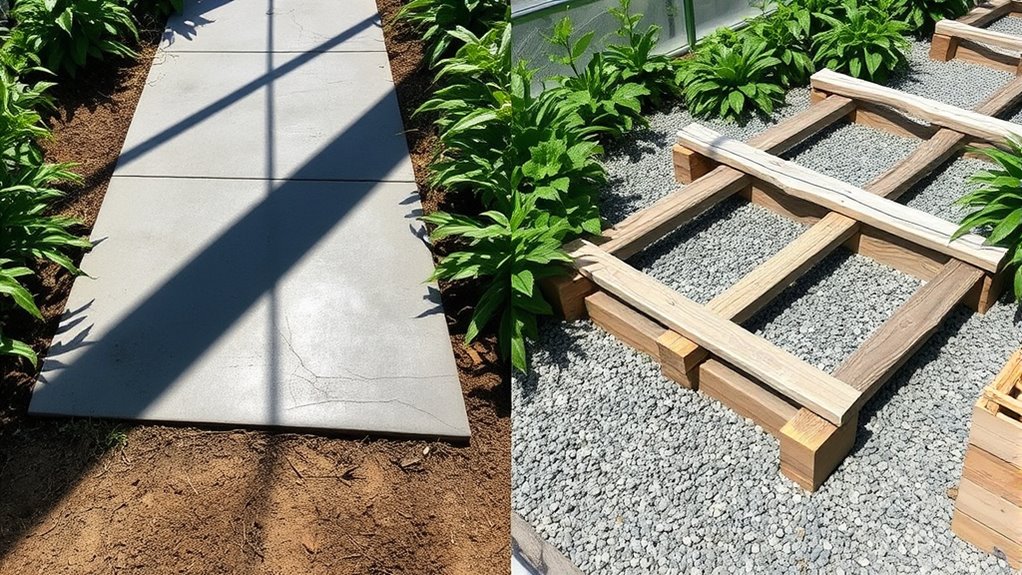
Choosing the right foundation for your greenhouse is crucial for its stability and durability, especially in varying weather conditions.
Concrete foundations provide maximum sturdiness, ensuring your greenhouse stays anchored during harsh storms. They’re durable and pest-resistant, requiring minimal maintenance. However, they can be more expensive upfront.
Gravel foundations are budget-friendly and allow for excellent drainage, though they may not support larger structures as well.
Wooden foundations offer cost-effectiveness and flexibility but need maintenance to prevent rot, especially in harsh climates.
Soil foundations are the cheapest option, best for smaller greenhouses, but require well-compacted soil for stability.
Each option has its strengths, so consider your specific needs before making a decision.
Aesthetic Considerations for Wooden Deck Foundations

How can a wooden deck foundation enhance the visual charm of your greenhouse?
A wooden deck offers a natural, rustic aesthetic that beautifully complements your garden. You can design it to match existing features like pathways or fences, creating a cohesive look.
With various wood types available, such as cedar or redwood, you can choose materials that suit your style. Plus, staining or painting wood allows you to coordinate with surrounding structures or garden themes.
The integration of the deck with your landscape not only enhances the visual appeal but also provides an inviting space.
Customization Options With Perimeter Bases
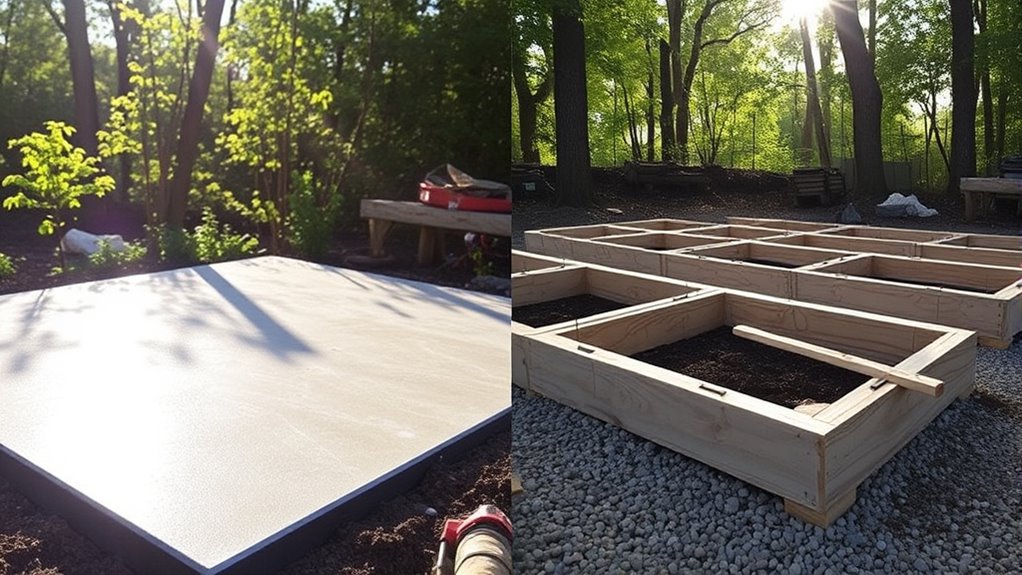
Perimeter bases offer a versatile foundation option for your greenhouse, allowing you to tailor the structure to your specific needs.
You can choose from various materials like concrete blocks, paving slabs, wood, breeze blocks, or bricks, depending on your budget and aesthetic preferences.
Wooden bases, in particular, let you easily adjust the height, while paving slabs provide a solid, level surface.
Additionally, you can design your perimeter base to enhance drainage and improve insulation with overlapping panels.
This flexibility makes it easier to adapt to different climates and ground conditions, ensuring stability and ease of installation.
With perimeter bases, you get a cost-effective solution that meets your greenhouse’s unique requirements.
Alternative Foundation Solutions: Pros and Cons

While each foundation option for your greenhouse has its advantages and disadvantages, understanding these can help you make an informed choice.
Gravel foundations are budget-friendly and easy to install, but they offer less stability than concrete.
Gravel foundations provide an affordable and simple installation option, though they may lack the stability offered by concrete.
Wood foundations are also cost-effective and adjustable, yet they require maintenance and rot-resistant materials.
Soil foundations are the cheapest for smaller greenhouses, allowing direct planting but lack the stability needed for larger structures.
Brick or cinder block foundations provide durability but may settle and require sealing to prevent pests.
The right foundation type can significantly impact your greenhouse’s longevity, so weighing these pros and cons will guide you in selecting the best foundation solution that meets your greenhouse’s specific needs and your budget.
Maintenance Requirements for Various Foundation Types
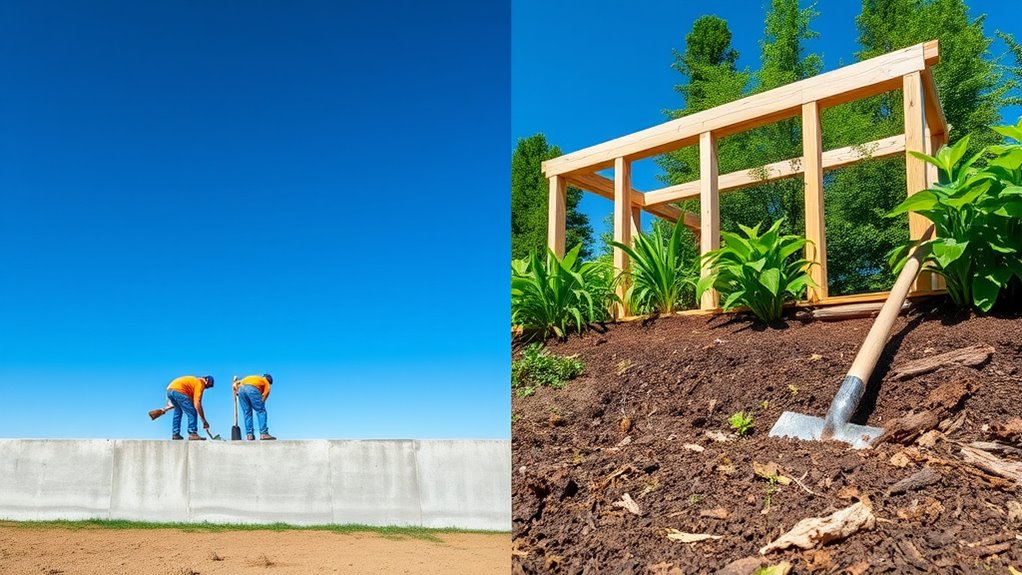
Choosing the right foundation for your greenhouse isn’t just about initial cost and installation; maintenance plays a significant role in the long-term success of your structure.
Concrete foundations require periodic sealing to prevent moisture damage, while wood needs regular treatments to guard against pests and rot.
Brick or masonry options demand regular inspections for settling issues and require sealing to keep pests out.
Regardless of the type, ensure you have proper drainage to avoid water accumulation.
Regular inspections are crucial to catch potential problems early, and adapting your foundation to local climate conditions can enhance durability.
Factor these maintenance costs into your budget to ensure your greenhouse remains stable and functional for years to come.
Frequently Asked Questions
How Do I Choose the Right Foundation for My Greenhouse Size?
To choose the right foundation for your greenhouse size, start by assessing the weight and dimensions of your structure.
For small greenhouses, a simple soil or wood base might do. Medium ones often need concrete or brick for stability.
Large and extra-large greenhouses require robust options like concrete slabs or footings.
Consider soil conditions, climate, budget, and local zoning requirements to ensure your foundation meets both functional and regulatory needs.
What Climate Factors Should I Consider When Selecting a Foundation?
When selecting a foundation for your greenhouse, consider climate factors like temperature extremes, precipitation, and wind.
You’ll need a foundation that can withstand heat and cold while retaining warmth in chilly conditions. If you live in a rainy area, ensure good drainage and use moisture-resistant materials.
Strong winds require stable foundations, so choose materials that anchor well.
Don’t forget to think about seasonal variations and how they’ll affect your greenhouse’s stability and insulation needs.
Are There Specific Permits Required for Greenhouse Foundations?
When you’re diving into greenhouse foundations, you’ve got to keep your ducks in a row regarding permits.
Depending on your location, you might need zoning permits, building permits, or even environmental permits. If you’re part of an HOA, check their rules, too.
Larger or commercial greenhouses often require more paperwork. Always consult local authorities to avoid any surprises and ensure you’re compliant with all necessary regulations before you start your project.
How Do I Ensure Proper Drainage Around My Greenhouse Foundation?
To ensure proper drainage around your greenhouse foundation, start by assessing the soil type and condition.
Create a slope away from the greenhouse to direct water flow. Implement drainage systems like French or trench drains, and consider using gravel for its excellent drainage properties.
Regularly inspect and clean these systems to prevent blockages, and be ready to adapt your drainage solutions as environmental conditions change.
Proper maintenance helps protect your greenhouse from water damage.
What Types of Plants Are Best Suited for Different Foundation Types?
Different foundation types suit various plants.
For stable, long-term plants like fruit trees, go for concrete.
Wooden foundations appeal visually and work well for ornamental plants like roses, while soil foundations are perfect for direct planting, ideal for veggies like tomatoes.
If you’re looking for excellent drainage, consider gravel for succulents.
Each foundation type meets specific needs, so choose based on the plants you want to grow!
Conclusion
In conclusion, choosing the right foundation for your greenhouse is crucial. Did you know that nearly 60% of greenhouse failures are linked to inadequate foundations? Concrete offers unmatched stability and durability, but other options like wooden decks or perimeter bases can also work well depending on your needs and budget. By considering factors like drainage and maintenance, you can ensure your greenhouse stands strong and thrives for years to come. Choose wisely, and your plants will thank you!
